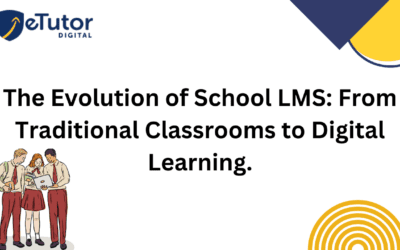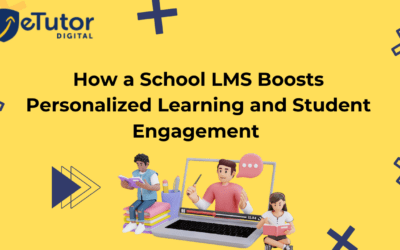Best Learning Management System for Schools in 2024

Technology has become a vital element of many facets of our life, including education, in today’s fast-paced digital society. Schools are increasingly resorting to Learning Management Systems for school (LMS) to improve their educational practizes due to the rapid progress of online learning.
These powerful platforms offer a plethora of tools and features aimed at streamlining content distribution, facilitating collaboration, and increasing student involvement.
In this blog, we will delve into the area of Learning Management Systems for School and investigate their educational benefits.
Table of Contents
ToggleWhat is Learning Management System?

LMS for School are software platforms that allow educational institutions to manage, deliver, and track educational content and activities in a digital context. They act as a central hub for teachers and students, allowing them to access instructional resources, assignments, exams, and communication tools.
Schools can select from a various School LMS Feature , ranging from open-source solutions to commercial options, each with its own set of features and functionalities.
Scalability, simplicity of use, customization possibilities, technical support, and pricing are all important factors to consider when choosing an LMS for a school.
Benefits of Implementing LMS in Schools
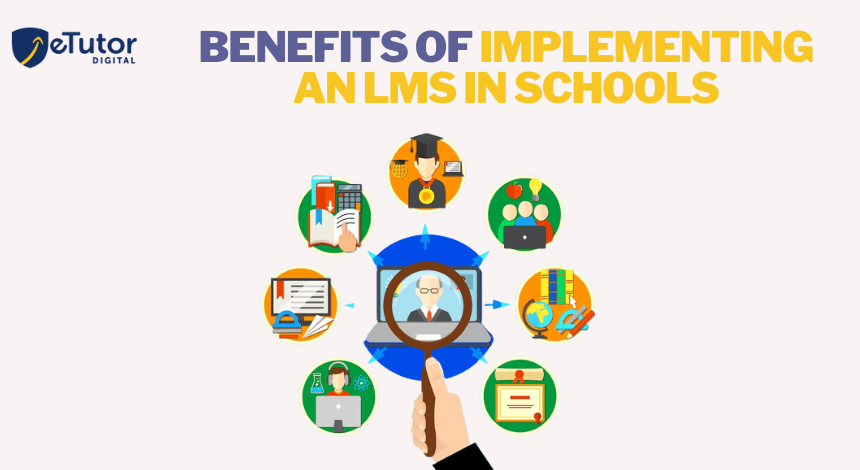
Enhanced Accessibility and Flexibility: LMS solutions allow students to access course materials and complete assignments at their own pace and convenience.
This enables personalized learning experiences that cater to a variety of learning styles and individual needs.
Streamlined Content Delivery and Organization: LMS platforms provide a systematic and organized method of delivering content.
Teachers can share resources, multimedia information, and interactive materials with students, making it easier for them to access and engage with the curriculum.
Efficient Assessment and Grading Capabilities: LMS platforms make it easier to create and deliver tests, as well as grade and provide feedback to students.
Automation features simplify manual procedures, save time, and maintain evaluation uniformity.
Collaboration and Communication Tools: LMS platforms enable teachers and students to communicate and collaborate in real time.
Even outside of the traditional classroom context, discussion boards, chat tools, and group projects stimulate interaction and information sharing.
Tracking and Monitoring Student Progress: LMS platforms include robust tracking and reporting tools that enable teachers to monitor student progress, identify areas for improvement, and deliver targeted interventions.
Personalized education and intervention tactics are possible with this data-driven approach.
Cost-Effectiveness and Resource Optimization: By decreasing the need for physical resources such as textbooks, paper, and classroom materials, an LMS can result in cost savings.
Furthermore, centralizing the management of course materials and assignments reduces administrative responsibilities.
Exploring Key Features of Learning Management System For Schools
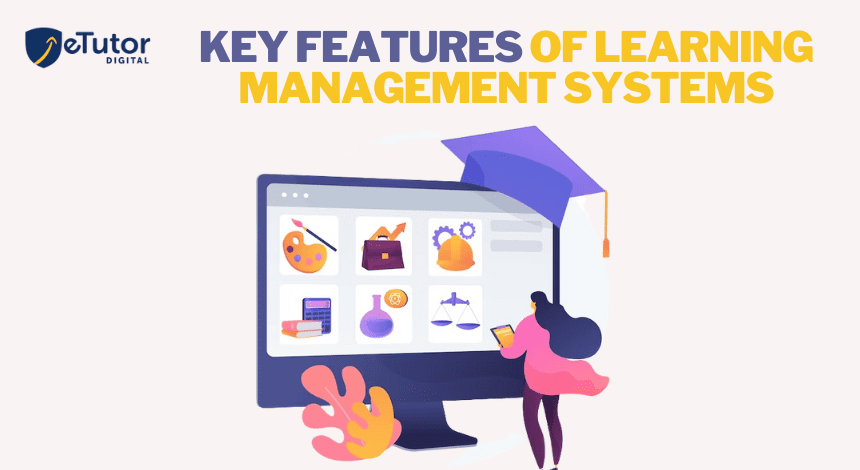
Learning Management Systems for School have numerous features and functionalities. Let’s look at some of the most popular characteristics found in LMS platforms:
Content Management and Delivery: LMS platforms allow teachers to upload and organize course materials, such as documents, videos, and multimedia content, for delivery. For ease of navigation and accessibility, content might be organized into modules or units.
Course Creation and Customization: LMS platforms include capabilities for designing and tailoring courses to suit curriculum objectives. Teachers can design interactive lectures, exams, and projects that are tailored to their students’ specific requirements.
Assessment and Grading Tools: Assessment options on LMS platforms include multiple-choice quizzes, essays, and assignments. These solutions automate grading, provide automatic feedback, and create comprehensive performance reports.
Communication and Collaboration Features: Teachers, students, and even parents can communicate and collaborate on LMS platforms. Discussion boards, message platforms, and virtual classrooms encourage participation and interaction.
Analytics and Reporting Capabilities: Comprehensive statistics and reporting on student performance, participation, and engagement are generated by LMS platforms.
These insights assist teachers in identifying areas for development, tracking progress, and tailoring instruction as needed.
Integration with Other Educational Tools and Systems: Many LMS solutions let you to integrate third-party applications like video conferencing software, plagiarism checkers, and learning analytics systems.
This integration improves the entire learning experience and boosts the LMS’s capabilities.
Best Practices for Implementing LMS in Schools
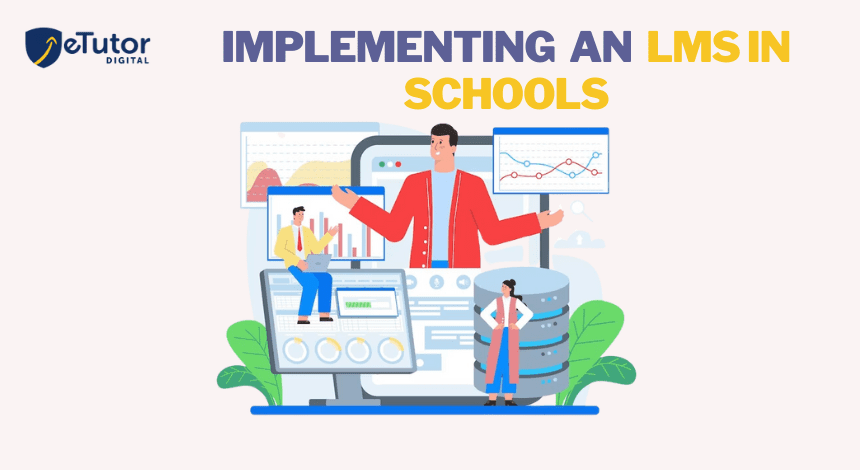
Implementing an LMS successfully requires careful planning and execution. Consider the following best practices to ensure a smooth transition:
Set Clear Goals and Objectives: Define the particular aims and objectives you hope to achieve by putting an LMS in place. Align these objectives with the school’s broader instructional plan.
Involve Stakeholders in the Decision-Making Process: Participate in the selection and implementation process by involving teachers, administrators, students, and parents. To improve buy-in and support, get their feedback and address their issues.
Training and Support for Teachers and Staff: Provide extensive training to instructors and staff personnel so that they are confident in utilizing the LMS. Provide continuing assistance and professional development opportunities to help them improve their skills and expertise.
Ensure Data Privacy and Security: When implementing an LMS, prioritize data privacy and security. Ensure compliance with applicable data protection legislation and put in place the necessary safeguards to protect student and staff information.
Monitor and Evaluate Effectiveness: Evaluate the impact and effectiveness of the LMS installation on a regular basis. Collect feedback from instructors, students, and parents to identify areas for improvement and make appropriate changes.
Case Studies: Successful LMS Implementations in Schools
Consider the following real-world examples of schools that have successfully integrated LMS platforms:

School X: School X changed traditional classroom instruction into a blended approach by implementing an LMS.
The LMS increased student outcomes by facilitating course material delivery, increasing student collaboration, and providing personalized feedback.
School Y: School Y implemented a learning management system (LMS) to increase student involvement and interaction.
Students were able to connect with their friends and teachers, share ideas, and collaborate on projects regardless of their physical location, thanks to online discussion boards and virtual classrooms.
School Z: School Z used an LMS to enable personalized learning experiences. Students were able to work at their own pace, access extra learning resources, and receive timely feedback, resulting in improved levels of student accomplishment and motivation.
Overcoming Challenges and Considerations
While deploying, Benefits of LMS for schools should be aware of the following potential obstacles and considerations:

Technical Requirements and Infrastructure: Ascertain that the school’s technical infrastructure is capable of supporting the chosen LMS platform. A sufficient amount of internet bandwidth, hardware compatibility, and ongoing technical assistance are all required for a successful implementation.
Staff and Teacher Buy-In and Adoption: Address concerns and prepare employees and teachers to overcome any resistance or reluctance. To encourage adoption, highlight the LMS’s benefits and success stories.
Ensuring Equal Access and Inclusivity: Make that the LMS is accessible to all students, especially those with impairments or limited access to technology. Make accommodations and alternative resources available to ensure fair learning opportunities.
Addressing Privacy and Data Protection Concerns: Make student data privacy and security a top priority. Implement robust security measures, obtain appropriate consents, and comply with relevant data protection laws to safeguard sensitive information.
Conclusion
Learning Management Systems (LMS) have transformed education by providing schools with sophisticated tools to improve teaching and learning.
Learning Management System platforms provide several benefits, ranging from optimizing content distribution to encouraging collaboration and personalized learning.
Schools may effectively integrate these systems into their educational practice, empowering students and instructors in the digital age, by carefully selecting an appropriate Learning Management System Consultant , setting clear goals, and following best practice.
Adopting Learning Management Systems for school is a critical step towards offering high-quality education that prepares students for future difficulties.
Frequently Asked Questions
Recent Posts
- How School ERP Software Maximizes Productivity and Minimizes Cost
- How Does ERP Software for Schools Help Educators?
- Why Educational Institutions Need Online Exam Software in 2025
- How Is AI-Based ERP Software Transforming School Administration?
- Latest IIT-JEE & NEET Exam Trends 2025 | Key Changes in JEE, NEET 2025 Exams By NTA




